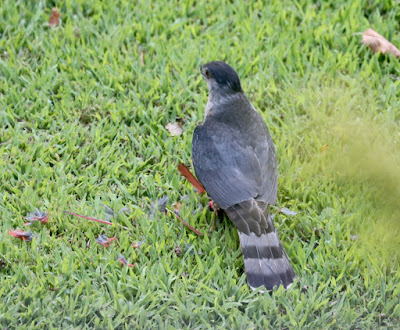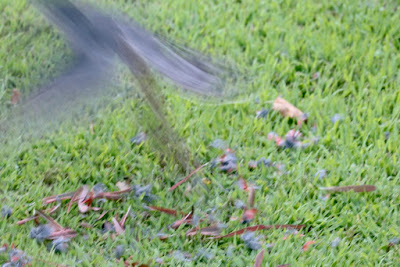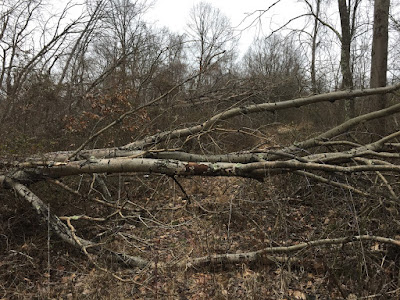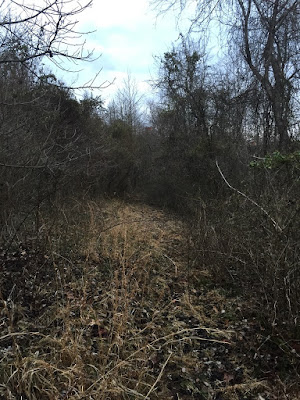Yes, I Still Paint Birds!
I know I've done at least a dozen of these over the years, and probably more, but my memory fails me. I went back into my emails to 2015, and searched my computer for jpegs of prior paintings, and between that and my hazy memory, I came up with ten commissions that I remember doing and for which I have photos. An early one was this great tinamou from 2008. That was FUN. Just had to show those highly polished turquoise eggs that make NO SENSE whatsoever for a ground-nester in Neotropical Predatorville, but somehow still exist, persist, and produce baby tinamous. Maybe the eggs are so beautiful, like precious treasure, to make the bird stay invested in sitting on them nonstop so nothing eats them. A just-so story from my hazy mind. Who can say why tinamous polish their turquoise eggs?
I really enjoyed painting this prothonotary warbler in the rain, 2012. I was thinking about what would be nice with its glowing golden color, and I settled on a rainy gray day, because green just seems to compete. As I sketched, I wondered if they ever used red maple flower petioles in their nests. Eastern bluebirds, also cavity nesters, like them and use them as a springy mattress in their nests, and it seemed to me that would be a good nesting material for a swamp bird (red maples being swamp trees). So I took a gamble and painted a male tugging on one against a rainy, watery backdrop. (First ascertaining that the male participates in nest building). Turns out, the award recipient knew that they DO use red maple petioles in their nests, and he was delighted with the little natural history factoid that informed the painting.
Sometimes the bird in question is one so deeply familiar to me that I have only to look out the window to sketch and observe it. Such was the American goldfinch pair, pictured in chicory on my own road. It was done in 2013, in a looser watercolor style, and I had fun with it.
I thought the recipient of a house wren, being an ornithologist, might enjoy an intimate, Baby Birds-style look into the nest, so I did a sort of decorative take on a nest that was in a box in my driveway in 2014. Pretty sure I painted this in 2017.
In the summer of 2019, I painted an American kestrel in a newly-mown field that I frequent. It's the monarch meadow, mown down in late June, before it springs back up to delight me and the butterflies in August. I felt I had to paint the kestrel in flight, though I struggled with myself, wanting to depict its ornate plumage close up, as in a sitting pose. Flying won out, because for me, it's as much about the setting as it is the bird itself. I wanted to paint a big space for that beautiful little dart to traverse. I have been playing with some of the more difficult colors in sky washes and having fun with that. Like, how do you make a blue sky grade to yellow without its going green in the middle? Well might you ask.
The answer is that you don't let the two colors touch enough to mix. You leave a sort of buffer of wet Chinese white, that serves to keep them from commingling and making a green band across the sky. The two colors kiss, but don't embrace. Chinese white is a solid body pigment and it settles into the paper and keeps the other pigments from spreading too much. At least that's how I think it works. Still, the effect is of a gradual gradation, and that's what I was after.
I loved doing the fieldwork for this one! Bobolinks, pictured with chicory and Queen Anne's lace in a place I know in McConnellsville, Ohio.
I like the dreamy nature of this one. In each of my paintings, I try to do something new, to stretch myself a bit and learn something. That keeps it fresh and fun. That, and the fact that I do maybe two commissions a year.
So that's a stroll through some of my Wilson Ornithological Society Klamm Award favorites. I thought it would be fun to give you a step-by-step of my latest, which was just gifted to a recipient who happens to be a friend. I'll tell the story of how that painting evolved and came to be in the next posts.
|
Widget for blogger by Way2Blogging | Via Spice Up Your Blog Gadgets
|
Sharp-shin or Cooper's? ID Lesson and Reveal
Sunday, August 9, 2020
15 comments
We're trying to hash out whether this is a sharp-shinned hawk (probably female) or Cooper's hawk(probably male). Female hawks are bigger than males, and that introduces a whole 'nother level of uncertainty in their ID. Is it a big female sharp-shin or a small male Cooper's? Who can say?
Now that you've had a chance to look at these shots, I'll tell you what I see in each one. You can see if your observations match mine.
This first picture shows the hawk's overall build--small and light--and long, rather matchstick-like and spindly legs. They don't look very substantial, do they? Maybe even a bit sharp on the leading edge. I always check the legs on any mystery accipiter. If they look so thin that you could snap them with your fingers, I think sharp-shinned.
Do this Cooper's hawk's legs look like you could easily snap them? Nope. He's got gams. He's also got big fluffy white undertail coverts. In Cooper's hawks, these are so long that they sometimes curl up over the top of the tail, especially in flight. In none of the mystery bird photos can you see any fluffy undertail coverts. This is not a diagnostic feature, but certainly a small piece of a confusing puzzle.
This angle on our mystery bird is dandy for ID. First, look at the way the black crown flows down back of the bird's neck, almost melding with the dark upper back. It's not a cap. It's more of a hood. Though there is a narrow lightish stripe between the hood and the back, this bird could not be said to have a pale nape, nor does it have a blackish round cap sitting atop the head, both typical of Cooper's hawk. This dark crown-hood, flowing into a dark nape, are sharp-shin traits.
Nice dark cap cutoff in this Cooper's hawk. Like it's wearing a little cap, not a hood. Super pale nape. Also note the wider white terminal tail band. Compare to photo above this one.
Now look at the tail in the shot above. There is a very narrow whitish terminal band. The tail feathers seem to be the same length throughout. In other words, the tail does not appear to be graduated, as a Cooper's hawk tail would be. Keep an eye on this in subsequent photos. You'll see a square-tipped tail, all the feathers seemingly of equal length: sharp-shin.
Here's a Cooper's hawk, with graduated (uneven length) tail feathers. (This is a feature visible ONLY from underneath, however!) The tail is, by any measure, long for the size of the bird. It's also showing that squarish, hatchet-headed profile. Bill is substantial.
Notice in all shots that the contour of our bird's crown is smooth and rounded. There is no hatchet-shaped crest off the back of the skull (a Cooper's thing).
Note also how delicate the bill appears, protruding from a rounded forecrown, and how large the eyes. Cooper's hawks have a heavier, deeper bill, which seems, at least to me, more a part of the hatchet-shaped head, not a little addendum like the sharpie's bill.
Cooper's hawk. Look at the squared off hindcrown, the abrupt end to the dark cap, and the entirely pale nape.
Cooper's will also show a characteristic this bird lacks: fluffy white undertail coverts. No fluffy panties on this gal!
This closeness in size comparison was a limited time offer, as the cardinal was soon reduced to smithereens.
And so, we'll bid adieu to this beautiful dark female sharp-shinned hawk, and wish her and her nestlings well. Tonight, they eat.
I was delighted to be able to use photos to walk through this ID of a sharp-shinned hawk. What a gift, what a treat. And my first thought, as always, was to share the thought process with you. And that's been great fun. Except that, in endless double-checking before publishing, I realized that I was wrong. The whole post above this line is basically wishful thinking. But I've left it just as I wrote it, so you can see the power of wishful thinking, of persuasiveness. Me, persuading myself it's a sharp-shinned hawk. Me, trying to persuade you that it's a sharp-shin.
It's not a sharp-shin.
Every dang field mark seemed to point to sharp-shin. I was ready to post it. But I knew that I had to be sure. So, like a good Science Chimp, I did some measurements.
I can't tell y'all how long I have been at it, looking for things I could measure. When did I post the first installment? Friday afternoon...and it's Sunday now. Since then, I've been stewing and working on this. Feathers, beaks... I found one entire central tail feather in this shot (below), and then used my cardinal specimen for the actual length of a cardinal central tail feather. With those two numbers, I could then measure the hawk in the shot, and solve for X (total length of hawk).
Cardinal tail feather in photo 38mm = 103 Cardinal tail feather actual
Hawk total length, photo 139 mm X Hawk total length actual
Using the tail feather as a known measurement, and solving for X,
the hawk's total length would be 376 mm, or almost 15" in life.
I wanted another hack at it, so this time I went for a comparison of the total length of the cardinal to the total length of the hawk.
So I measured the cardinal's body and tail separately in this shot, and then extrapolated as if the bird were stretched out straight. I knew from my own specimen, made from a window-kill, that a stretched out cardinal is 215mm long.
Here's the equation for that.
Cardinal total length in photo 68mm = 215mm Cardinal total length actual
Hawk total length in photo 133 mm X Hawk total length actual
Using this equation, I got a total length for the hawk of 420 mm or 16 17/32"
Sharp-shinned hawk females measure from 290-340 mm (11 52/64" - 13 25/64")
The largest female sharp-shin comes in around 13 1/2"
Cooper's hawk males measure around 390 mm (15 23/64")
Using either measurement, the hawk is too big to be a female sharp-shin. It has to be a Cooper's hawk.
For me, this exercise was an incredibly time-consuming but very powerful demonstration of several things.
First is the power of wishful thinking. I wanted that bird to be a sharp-shinned hawk! Sharpies are declining; Cooper's are exploding, and I wanted to go back to the good old days in the mid-1990's, when I found two sharpshin nests in the pines just beyond our south property line. I was so happy to have them, even though they picked off baby bluebirds in my yard. So when I looked at that ambiguous bird, my hungry eyes searched for evidence that it was a sharp-shin.
--Those thin legs looked spindly to those hungry eyes. But all hawk legs look spindly from the front and thicker from the side. It's how they're built-laterally flattened.
--That long, dark cap extending down the nape looked like a sharp-shin's hood, not a Cooper's beret. Still does. I wouldn't call that a "pale nape." But there you go. Their plumage coloration varies.
--On the graduated (Cooper's) vs square (Sharpie) tail: To be perfectly honest, if you can't see the underside of a bird's tail, you can't say if the feathers are graduated in length or not, so we can throw that one out.
--No fluffy undertail coverts like a Cooper's? Well, I guess it just has them tucked up. It's not exactly relaxed while killing its prey.
Second is that this stuff--differentiating sharp-shinned from Cooper's hawk-- is HARD. This is, by any measure you choose, an ambiguous bird. Is it a large female sharpie or a small male Cooper's? Well, Phoebe and I got pretty darn good shots of it and I couldn't tell. I thought I knew! But in the end, I didn't. I hope that makes you feel better when you throw up your hands over a bird plucking something in your backyard. Honestly, it's easier to tell them apart in flight!
Third is that numbers don't lie. But photos can.
In this photo, before the plucking started, it looks like the cardinal and the hawk are practically the same size.
Put them in profile, and ehhh--not so much. The hawk dwarfs the cardinal. Why couldn't I see that before?
Because I wanted it to be a sharp-shin. Back to Tenet 1: the power of wishful thinking.
And that's why I did the analysis, because I had to be sure. I couldn't proclaim that this was a sharp-shinned hawk and that we were all going to learn something about raptor ID without due diligence. And that due diligence gave me data that forced me to reach a different conclusion--that it's a Cooper's hawk. Probably a male. Heck, I can't even say that for sure. But I think it's a male Cooper's hawk.
Presented with new data, I reached a new conclusion. If you don't remain flexible in your thinking; if you close your mind to new information, you're going to be wrong a lot.
I'll leave you with this shot of my cardinal specimen, made from a roadkill* in May, 1986. Just above its head is the skull of a male sharp-shinned hawk that hit the tower window in August, 2017. He'd been nesting nearby; I knew it because he was grabbing birds at the feeders all summer long, and I heard his fledged young keening in the north border. Look at the size of his skull compared to the cardinal's. They're practically the same size. Can we say that about the mystery hawk and its cardinal prey? Nope. We can't. Measurements don't lie, numbers don't lie, and neither does the Science Chimp.
It's a male Cooper's hawk!
 |
| *specimen beautifully prepared by Rob Braunfield |
|
Widget for blogger by Way2Blogging | Via Spice Up Your Blog Gadgets
|
Sharp-shinned or Cooper's Hawk?
Friday, August 7, 2020
22 comments
Phoebe, Liam and I were eating a delicious pot pie at our outdoor table, with freshly picked sweet corn and garden green beans when we felt a rush go by, heard a small squeaky yelp and the twittering thunder of mourning dove wings, and knew that a hawk had claimed its meal under the feeders. Phoebe sprinted for the house, as she saw it land in the backyard, grabbed my big rig, and took this first photo through my studio window. It's a dandy. The cardinal is still intact in Phoebe's shot, but he won't be for long.
I thought it would be kind of fun to go through the process of identifying this bird. So in my first post I'll post the photos, so as to let you soak it in and decide for yourself what you're seeing,
and in my second I'll give an explanation of what I'm seeing in each one. Each photo has at least one good clue to the bird's ID. This photo has two:
It's interesting and doubtless disconcerting to some to see it deconstruct the cardinal more with each frame.
This bird just tore him apart before our eyes, removing and discarding one wing with a single bite. Mercifully, the cardinal was dispatched first, so he wasn't here for any of this.
So take your guesses and give your reasoning, if you're so inclined, in the Comments section.
If it makes you feel any better I had to really look at these photos and talk to myself a lot, to make sure that this bird is what I think it is.
The bird never ate a bite, just plucked furiously and flew, which tells me it most likely has babes to feed. The frequency with which we've been seeing it this summer argues for its being a resident with a nest. We've had this species nest just off our land in years past, so it was good to see it again. This is good news for biodiversity, and bad news for cardinals.
|
Widget for blogger by Way2Blogging | Via Spice Up Your Blog Gadgets
|
The Mess Out There
Sunday, August 2, 2020
6 comments
That slight birdy diversion aside (and there will be others), I would like to dwell in this post on the sorry state of my old orchard after the twin blows of a vicious derecho and the death of my husband, who was the sole chainsaw wielder in the family.
These photos were taken in January 2020, hence the dreary Mid-Ohio Valley monochrome. I couldn't get through it, couldn't go around it...it was bad.
Every path looked like this, punctuated by multiple downed trees. Bill counted 32 down right after the storm. Some of them he was able to clear. Most he couldn't.
There were some good sized trees out there, far too big to lever aside. Chainsaw time. And I lack the skills.
It was disheartening, annoying, and there was nothing I could do about it without machinery.
I clipped and cleared as much as I could so I could clamber over the logs, but the fact of them remained, and they weighed heavy on my mind. If you can't get a tractor through to brush hog, you're just going to have to give up getting through at all.
Some of them you couldn't get under, and couldn't go over.
Ugh.
And the walls were closing in. Multiflora rose, honeysuckle and poison ivy was threatening to choke off the paths altogether. You couldn't even get a tractor through in some places.
The absolute worst mess was the former clearing, where we used to build our New Year's sweatlodge and have bonfires. Two huge black oaks came crashing down, putting an end to the clearing.
All this was weighing on my mind as I watched the Amish crews working on the house roofing and siding. They worked like they wanted to work, like they liked to work. So as I was thanking them for their amazing speed and professionality, I asked Daniel Yoder if he knew anyone who might be willing to take a chainsaw (and maybe a Bobcat) to my pathetic mess of an orchard.
"Yeah, we could do that," he replied. My knees nearly buckled. The thought that someone would be willing to tackle this mess for me was so alluring, so fantasmagorical, so undreamt...
I guess you have to realize how long I'd lived without hope of finding anyone, or being able to afford hiring anyone around here, to understand how astonished I was to hear him say he could find the men to tackle it. It was February. The weather was awful. And they wanted to do this for me, soon. Now. I literally would have paid anything, because I'd been trying to get people out to help me for so long, and it just hadn't happened.
Daniel and I walked the orchard, and it didn't take long for us to decide that it needed more than men on foot wielding chainsaws. It needed a Bobcat, or "skid steer," as he called it. The mounds and mountains of multiflora rose had grown up everywhere, and hand-cutting them would be a nightmare compounded. The only thing for it was to push them all the hell off to the sides, uprooting them as they went, then keep the cleared areas mowed so the rose couldn't establish a foothold again.
And so it was, just a few days later in a light rain, that I stood on the raised deck and beheld the first assault: a hideously overgrown mess of rose and honeysuckle that had formed mounds around fallen trees just beyond the yard and Liam's willow. Oh, to see that little skid steer push that awful rose away! The crack and crackle of my worst enemy, defeated and pushed back. For once, the roar of a chainsaw and beep of a bulldozer was music to me.
We were on our way to recovery, to making the orchard a nice place to be again. It would be a long road, but a good one.
|
Widget for blogger by Way2Blogging | Via Spice Up Your Blog Gadgets
|
Labels:
clearing brush,
land management


































Wednesday, August 26, 2020
15 comments